In this post, we will discuss how to undervolt GPU and if it is good to undervolt your graphics card. If you find that your graphics card is too loud and too hot while playing heavy-load games and the settings aren’t as expected, then GPU undervolting can be helpful. Though factory settings are good enough most of the time, you might feel the need to undervolt GPU. So, for those who want to undervolt GPU, the instructions and a detailed explanation covered here will come in handy.
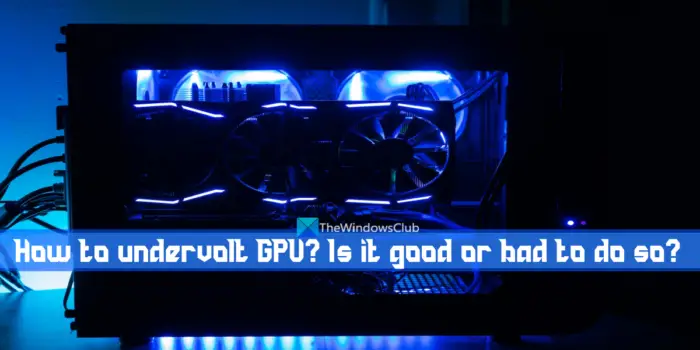
Though the undervolting process for a graphics card can be done easily if all the steps are performed carefully, not all graphics card models support undervolt or those shouldn’t be undervolted. While GPU undervolting should be possible in nearly all AMD graphics cards, NVIDIA GPUs below GeForce 10 series, on the other hand, may not be supportive. Before trying to undervolt your GPU, let’s have some more information about it including a few benefits.
What is GPU undervolting?
Undervolting GPU (Graphics Processing Unit) means lowering or reducing the operating voltage of the graphics card or video card to the optimal level while keeping its core clock speed the same. That simply means your GPU has access to the higher operating voltage by default or with factory settings but it can be lowered down to a safe limit or optimal minimum voltage for the same GPU frequency.
For example, let’s say your GPU runs out at a maximum of 1850 frequency (MHz) for 1000 voltage (mV) with the default setting. Here, you can lower the voltage to 975 mV or 950 voltage for the same frequency (i.e. 1850) if everything goes fine and you don’t face any issues. This is GPU undervolting.
By doing so, your graphics card will be cooler (with reduced temperature) comparatively which will be helpful for the overall lifespan of the GPU.
Undervolting GPU also reduces power demand and it will be less noisy, which is why you may want to undervolt your graphics card. In addition to that, if the core clock frequency and voltage is fluctuating quite a bit with default settings configured, then it would be another reason to undervolt a graphics card. Now we have a good understanding of GPU undervoting, let’s check how it can be done.
How to undervolt GPU?
If you want to undervolt GPU, it can be done safely but it is a trial-and-error process. In this post, we have covered separate sections for undervolting an NVIDIA graphics card and an AMD graphics card as there is some difference between both options. Let’s start with the NVIDIA GPU first.
Undervolting an NVIDIA graphics card
To undervolt an NVIDIA graphics card, you can use the most popular and universal graphics card tool called MSI Afterburner. It is an all-in-one GPU underclocking, benchmarking, undervolting, GPU monitoring, and overclocking software available to use for free. Now let’s check the entire process using the following steps:
- Install the MSI Afterburner
- Perform graphics card test
- Check GPU frequency on MSI Afterburner interface
- Open Voltage/Frequency curve editor graph
- Undervolt your GPU
- Maintain maximum GPU frequency and voltage level
- Save the changes
- Stress test GPU
- Repeat the process.
Let’s check all these steps one by one in detail.
1] Install the MSI Afterburner
Grab the ZIP file of MSI Afterburner from msi.com. Install it and open its interface. You will see GPU frequency (MHz), CORE VOLTAGE section, CORE CLOCK (MHz) section, CURVE EDITOR, etc. You will need some options that are highlighted in the image below later.
2] Perform graphics card test
Now perform the graphics card test for the maximum utilization to find the maximum frequency (core clock speed) under stress. To do it easily, you can run a GPU incentive game or a program and let it keep running for at least 10-15 minutes in windowed mode. Even better, you can use some free benchmark software like FurMark that includes GPU stress test and windowed mode.
3] Check GPU frequency on MSI Afterburner interface
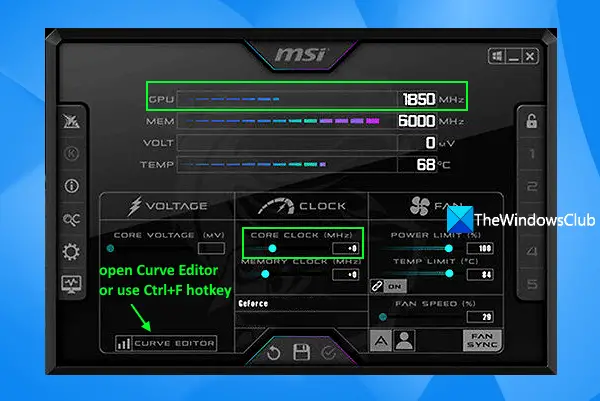
Come back to the MSI Afterburner tool interface. That’s why you need to run the GPU stress test in windowed mode so that you can come back to this utility easily. Look for the GPU frequency (MHz) on the top section and note it. Let’s take the example of the screenshot presented above. Here, you can see the GPU frequency is showing for 1850 MHz.
4] Open Voltage/Frequency curve editor graph
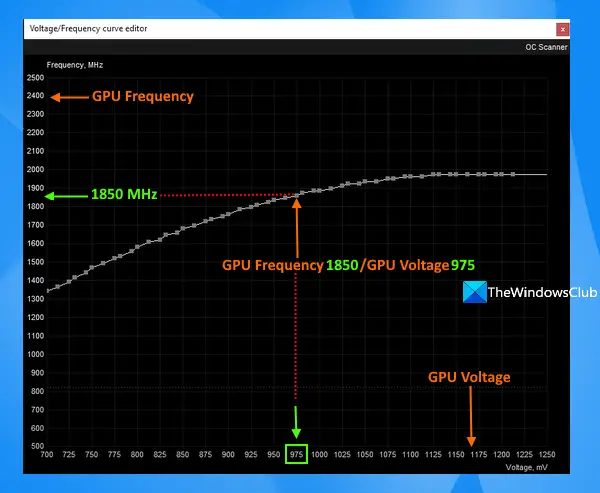
On the main interface of MSI Afterburner, press the Ctrl+F hotkey or click on the CURVE EDITOR option you see in the bottom left section. This will open a Voltage/Frequency curve editor graph in a separate box. Keep that box side by side with MSI Afterburner’s main interface and set it to a position where you can access both easily. That box will show you a curve with small square boxes for Voltage (mV) usage on X-axis and GPU core clock speed or Frequency (MHz) usage on Y-axis on that graph.
Look for the frequency that matches the GPU frequency you get in the GPU test and then check its correspondence voltage. Let’s say for 1850 MHz frequency on the curve, it shows 975 voltage (as visible in the screenshot added above). This would vary depending on the stress test and graphics card you’re using. So, you should carefully look at your own Stats on that graph.
5] Undervolt your GPU
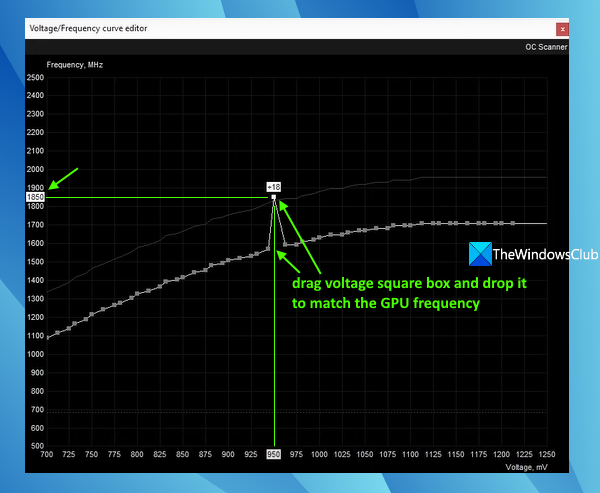
Now for undervoting, you can start by lowering the voltage to 25 mV (millivolt), say from 975 mV to 950 mV keeping the same frequency (i.e. 1850 MHz). For this, you need to lower the graph by doing the underclocking work. Come back to the main interface of MSI Afterburner, enter a value say -250 in the CORE CLOCK (MHz) option, and press the Enter key. You will see the graph is changed and lowered, the same as shown in the screenshot above.
Now, click on the small square box pointing to 950 mV and drag it upwards to match the GPU frequency (in this case, 1850 MHz). Remember, these figures could be different for you. This is just an example to help you in performing the undervolting process.
Related: How to underclock GPU? Is it safe to do so?
6] Maintain maximum GPU frequency and voltage level
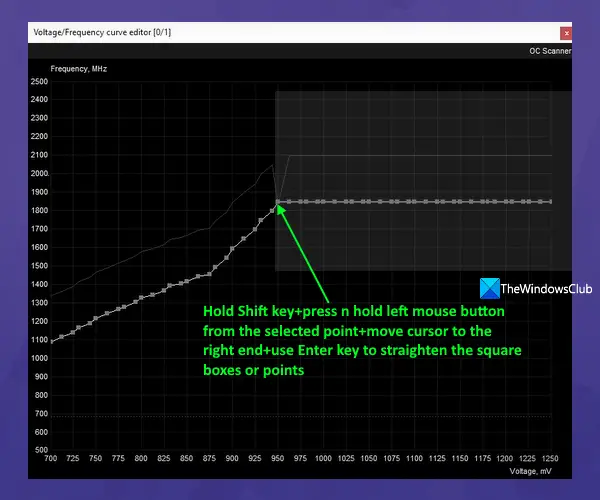
You also have to flatten the curve to the right side after the chosen voltage point and frequency point to max out the GPU voltage chosen by you. This is to make sure it doesn’t fluctuate and go beyond the chosen points and result in any instability.
For this, place your mouse cursor above the small square box that you set for the new voltage (950 mV) and GPU maximum frequency, hold the Shift key, press n hold the left mouse button and drag the cursor to the right till the end, and hit the Enter key.
It will flatten the curve and you will see all the squares (available next to the pointing voltage) are in a line. You can also do this manually but that would be time-consuming.
7] Save the changes
Finally, save these changes. For this, click on the tickmark button or Save icon available on the MSI Afterburner interface, and done. You’ve undervolted GPU.
8] Stress test GPU
The work is not completed yet. You should test your graphics card and system for stability. Play a GPU-intensive game or even better use a GPU benchmarking tool and see if everything goes fine as expected. Basically, what you need to do is check everything runs smoothly, and that you don’t get any crashes or other issues with GPU or other programs that use GPU.
You can check the Voltage/Frequency curve editor graph using the MSI Afterburner utility to check the output after undervolting. If you see that the GPU frequency is hitting the same point that you set earlier within the set voltage level, then it’s good. If not, try to increase the frequency a bit (keeping the same voltage) and check the results again.
9] Repeat the process
As we mentioned already, it’s all about trial and error. You need to repeat these steps until you find the optimal level for the voltage and GPU frequency combination. Just don’t increase/decrease the voltage level too much.
If you get the output you expected, you can keep the same frequency and voltage level. You can even further lower the voltage by 25 mV and do the test. Just go slowly and check the results.
That’s it! Now let’s check the steps to undervolt an AMD GPU.
Read: What is PC Overclocking; Is PC Overclocking really worth it?
Undervolting an AMD graphics card
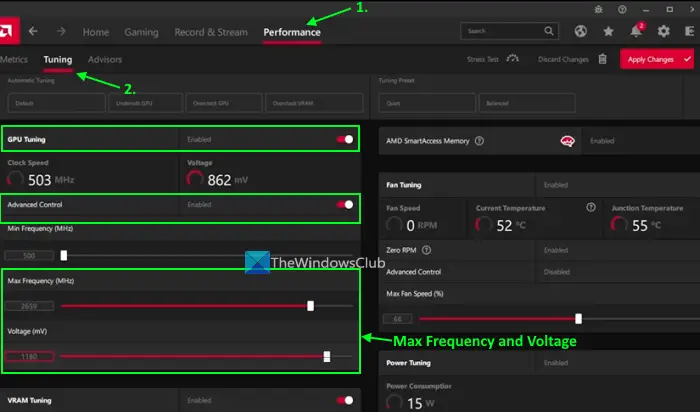
Undervolting an AMD GPU is comparatively much simpler than an NVIDIA GPU as it provides its own tool for that. Though you can use MSI Afterburner with an AMD graphics card, using the native tool is convenient. Here are the steps:
- Download and install the AMD Radeon Software from amd.com compatible with your graphics card. If you have already installed it, then you should update it to the latest version (Adrenalin Edition)
- Open your AMD Radeon Software interface. You can right-click on your Windows 11/10 desktop and use the AMD Software option, open it using the desktop shortcut, or use its taskbar system tray icon
- Switch to the Performance tab
- Go to the Tuning section
- Expand the GPU section
- For the Tuning Control section, select the option available for Manual Tuning. The option will be set to Custom
- Turn on the GPU Tuning button or use the GPU Tuning toggle to turn it on
- Turn on the Advanced Control button. You must turn on this option so that you can have actual numbers for GPU core clock speed (or Frequency) and corresponding voltage in MHz and mV. Otherwise, you will have both numbers in percentage which won’t give you a better idea
- Now you will see sliders for Max Frequency (MHz) and Voltage (mV) and number boxes to set the values. You need to set your sweet spot. For example, if the GPU maximum frequency is set to 2400 MHz, you may want to set the Voltage to 1000 mV. You should decrease the voltage level by say 10 mV or 15 mV. Don’t decrease it too much
- Press the Apply Changes button.
Run a GPU-intensive game or use a GPU benchmarking tool (like Unigine Heaven Benchmark) for the stress test. If the game runs smoothly or the application you’re using doesn’t crash, that means the new voltage level is optimal. If not, use the steps covered above and increase the voltage level accordingly.
Again, if now everything goes smoothly, you can further repeat the above steps and drop the voltage level to another 10 mV and perform the stress test, just to find the best optimal voltage level against GPU maximum frequency.
After undervolting, you will notice that there is a good drop in the power consumption for your GPU (and temperature as well).
Also read: AMD or NVIDIA Graphics Card not detected on Windows
Is it good or bad to undervolt GPU?
Undervolting GPU is surely gonna help you with lower power consumption for GPU, lesser heat generation, and make less noise. And yes, undervolting a graphics card is good and safe if the default settings are not optimal. On other hand, if the stock settings or factory settings for your graphics card are good, keep it as it is, no need to do anything. If you have to undervolt GPU, do it little by little. Carefully follow the instructions and everything will be just fine. Even if a game or application crashes, no need to panic. You just need to increase the voltage level a bit to match it with the maximum GPU frequency and repeat the process.
What happens when you Undervolt your GPU too much?
When you undervolt your GPU too much, it lowers the voltage too much all at once. Undervolting doesn’t damage your graphics card. Otherwise, it will result in crashes and instability which is not good as you again have to adjust the voltage level with maximum core clock speed. What you should do is undervolt your GPU step by step and keep it to the optimal level. This post includes a detailed explanation for undervolting GPU.
Read next: DDR3 vs DDR4 vs DDR5 Graphics Card: What is the Difference?